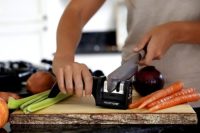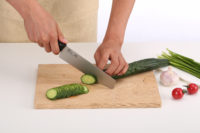Sharpening serrated blades and gut hooks require either a specially-shaped sharpener or abrasive material and a different sharpening technique. Usually, a tapered, round file style sharpener or typical pull-through style sharpener with specially-shaped abrasive stones will achieve the most consistent results.
Serrations

The serrated edge has notches or teeth like the cutting edge of a saw. In general, the serrated edge will work better for slicing cuts, especially through hard or tough surfaces, where the serrations tend to grab and bite (or pierce) through the surface quickly. Serrated Edge blades require a tapered rod or triangular-shaped surface to sharpen. These unique shapes allow you to sharpen the whole cutting edge of the serration as well as the tips. If you use a flat stone to sharpen serrations, you can only sharpen the tips of the serrations.
- Normally, serrations have a grind on one side of the blade only. Sharpen the grind side only.
- If you are NOT using a sharpener with fixed angles, Hold the sharpener at the angle that matches the original edge angle. Fixed angle sharpeners eliminate this requirement.
- If using a tapered rod style sharpener, put the pointed, narrow end of the sharpener up against the serration and stroke the sharpener into the serration—away from the edge of the blade, toward the spine. Stop stroking when the width of the taper sharpener gets to the same width as the serration (do not enlarge the width of the serration)
- Rotate (spin) the sharpener as you go for even, consistent sharpening.
- Check progress and continue until sharp.
NOTE: Sharpening serrations on a flat stone will only sharpen the tips of the serrations. Although not optimal, just sharpening the tips alone will improve results.

Gut Hooks
- Like serrations, the gut hook requires a tapered rod to sharpen the edge.
NOTE: Do not try to fill the entire width of the gut hook with the wide end of the sharpener. This will enlarge the gut hook curve and distort the cutting edge.
- Put the pointed, narrow end of the sharpener up against the open end of the gut hook. The narrow, pointed end of the sharpener should face in toward the thickness of the blade, away from the edge of the gut hook.
- Hold the sharpener at the angle that matches the original gut hook edge angle. This will maintain the correct sharpening angle and prevent you from getting cut by the blade tip. If applicable, make sure to hold the same angle when sharpening each side of the gut hook.
- In a forward and sideways motion, stroke the sharpener from one side of the gut hook to the other. Spin the sharpener as you go. As with sharpening a blade edge, the objective is to start at the edge and stroke away from the edge.
- Alternate blade sides if needed. Do the same number of strokes on each side of the blade’s gut hook if it is ground on both sides. Keep the number of strokes to a minimum to avoid distorting the gut hook shape.
- Check progress and continue until you feel desired sharpness.
Sharpening Fish Hooks and Small, Pointed Objects

Sharpening fish hooks and other small, pointed objects (darts, needles, etc.) requires a straight-line sharpening groove. Do not use a flat stone to sharpen these objects.
- Place the fish hook or pointed object in the groove, with the point in the same direction you will stroke.
- Hold the hook or point in the groove and stroke it to the end of the groove.
- Because you are working with a small, thin object, exercise restraint
- Check progress frequently—a few strokes may be all you need.
- Do not use a lot of pressure when stroking.
- Check progress and continue until you feel desired sharpness.

Frequently Asked Questions
What is the best Sharpener?
The best sharpener is the one that does what you want it to do. You should choose your sharpener based on your sharpening needs, your sharpening expertise, and type of sharpening material needed to achieve the edge sharpness required. No matter what sharpener you choose, they all will work, but in their own unique way.
What is the best angle to sharpen your knife?
The consistency of your angle is more important than the degree of the angle that you use. Keeping a consistent sharpening angle on both sides gives you the sharpest possible edge. We recommend a 23⁰ angle per side as the best general purpose-sharpening angle on most sporting and outdoor knives. You can use whatever angle you wish or feel comfortable using, but remember to use the same angle on both sides in order to achieve the sharpest possible edge.
How often should I sharpen my knife or tool?
The only way to keep a sharp knife or tool is never let it get dull. We recommend that you touch up your knife or tool after every use, which makes it quick and easy to re-establish a sharp edge. If you let your knife or tool edge get dull, it is harder and takes more time to re-establish the edge to the desired sharpness.
How do I know when my knife is sharp?
You can test you knife by cutting a piece of paper or you cut food with it to see if it is sharp. Some people think shaving hair from your arm indicates your knife is sharp, but we do not recommend this method. Over sharpening your knife can be just as bad as not sharpening your knife. Once you obtain a sharp edge, stop sharpening.


